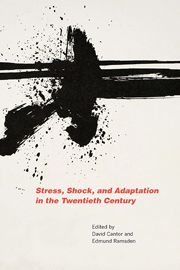Book contents
- Frontmatter
- Contents
- Acknowledgments
- Introduction
- Part One Packaging Stress
- Part Two Trauma and Acute Stress
- Part Three War
- 5 “Stress” in US Wartime Psychiatry: World War II and the Immediate Aftermath
- 6 The Machinery and the Morale: Physiological and Psychological Approaches to Military Stress Research in the Early Cold War Era
- Part Four Work
- Part Five Managing Stress
- Part Six Surveilling Stress
- List of Contributors
- Index
6 - The Machinery and the Morale: Physiological and Psychological Approaches to Military Stress Research in the Early Cold War Era
from Part Three - War
Published online by Cambridge University Press: 05 April 2014
- Frontmatter
- Contents
- Acknowledgments
- Introduction
- Part One Packaging Stress
- Part Two Trauma and Acute Stress
- Part Three War
- 5 “Stress” in US Wartime Psychiatry: World War II and the Immediate Aftermath
- 6 The Machinery and the Morale: Physiological and Psychological Approaches to Military Stress Research in the Early Cold War Era
- Part Four Work
- Part Five Managing Stress
- Part Six Surveilling Stress
- List of Contributors
- Index
Summary
During World War II the US miliatry launched an extensive initiative aimed at fighting the debilitating phenomenon of combat stress in its ranks. Even after the war, however, as Cold War tensions threatened to erupt in Korea, the prevention of soldier breakdown due to the psychological or emotional pressures of combat continued to present an urgent problem, and the military was keen to draw on any available tool to increase the effectiveness of soldiers on the battlefield. While psychology and psychiatry had provided certain insights during World War II on how morale and leadership could help to mitigate soldier failure, the 1940s had wrought another route for investigating and solving the problem of combat stress in the form of new physiological knowledge about the role of the pituitary and adrenal hormones in responding to stress. In the early 1950s stress research within the military context sought to mobilize the most recent laboratory studies on endocrine stress responses and integrate them with the knowledge gained by military psychiatrists, all in the effort to keep their soldiers in top fighting form and, ultimately, ensure American security in an uncertain time.
The present chapter seeks to explore more deeply how the physiological concept of the stress response became constitutive of combat-stress studies by analyzing three episodes from military stress research in the 1950s: the 1952 Study of Combat Stress in Korea from the Johns Hopkins University's Operations Research Office; the 1953 Symposium on Stress held at the Walter Reed Army Medical Center; and the “psychoendocrine” research of the physiologist John W. Mason and the psychologist Joseph V. Brady at Walter Reed's Division of Neuropsychiatry.
- Type
- Chapter
- Information
- Stress, Shock, and Adaptation in the Twentieth Century , pp. 142 - 186Publisher: Boydell & BrewerPrint publication year: 2014

